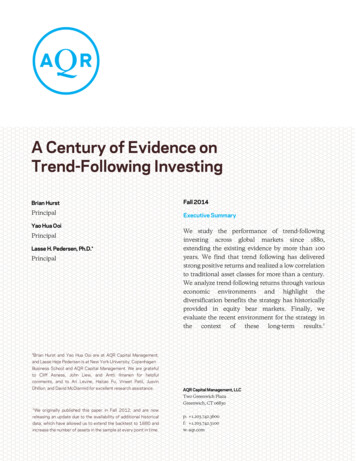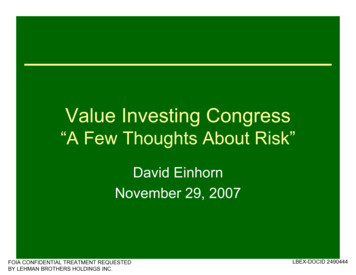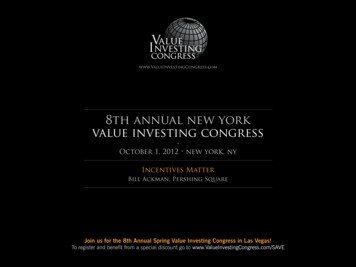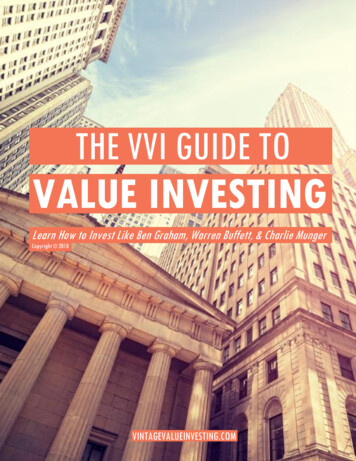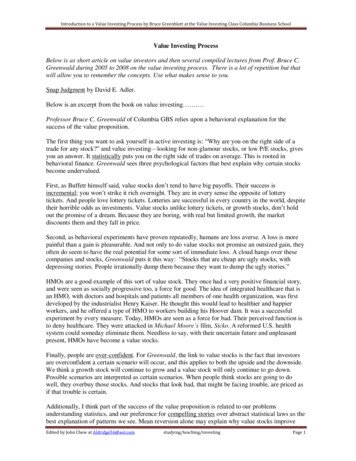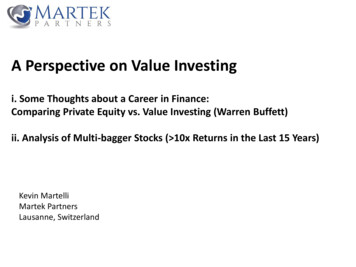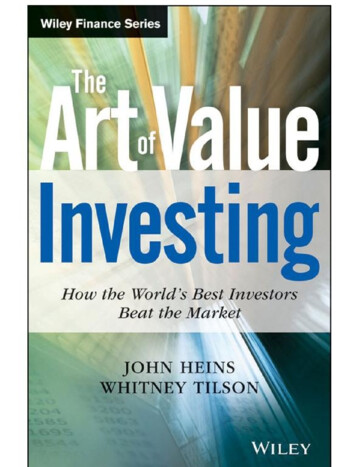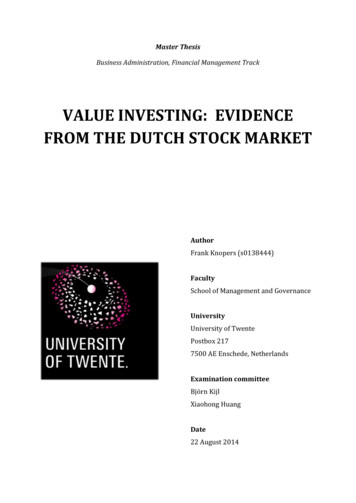
Transcription
Master ThesisBusiness Administration, Financial Management TrackVALUE INVESTING: EVIDENCEFROM THE DUTCH STOCK MARKETAuthorFrank Knopers (s0138444)FacultySchool of Management and GovernanceUniversityUniversity of TwentePostbox 2177500 AE Enschede, NetherlandsExamination committeeBjörn KijlXiaohong HuangDate22 August 2014
VALUE INVESTING: EVIDENCE FROM THEDUTCH STOCK MARKETAbstractThis study tests the performance of value investing strategies for the Dutch stock marketusing stock market data covering the period between 1995 and 2013. The topic of valueinvesting has been covered extensively in the financial literature, but there is not muchevidence on the effectiveness of value investing on the Dutch stock market. The purposeof this article is to strengthen the evidence using a large dataset covering the last twentyyears. The data for this research is based on stocks trading at the Euronext Amsterdam.The purpose of this research is to test whether price/earnings ratio, book value tomarket value, price to cash flow and dividend yield are effective value indicators for theDutch stock market. Previous research has shown that many of these indicators do havea correlation with the performance of a stock portfolio. Added to the most familiar valueindicators are less familiar indicators such as return on assets (ROA) and return oninvested capital (ROIC).Earlier research on the topic of value investing provides strong evidence of the ‘valuepremium’. Portfolios based on stocks with a low valuation tend to consistentlyoutperform portfolios with highly valued stocks. This study tries to measure the valuepremium on the Dutch stock market and if present, which indicators are the strongest.The results of this study show there is indeed a value premium on the Dutch stockmarket, consistent with the majority of the international evidence. The value premiumhowever differs from one indicator to the next. The price to earnings ratio (P/E), thereturn on assets (ROA) and the return on invested capital (ROIC) are the strongest valueindicators. The results also show some value premium for stocks with a high book tomarket value ratio and for stocks with a high cash flow yield. The relationship betweendividend yield and stock performance was unclear.Keywords: value investing, growth stocks, value stocks, glamour stocks, portfolio analysis2 Page
Table of contentsPreface . 4Abbreviations . 61.Introduction . 72.Literature review . 93.4.5.6.2.1Evidence supporting value investing . 92.2Alternative explanations on the value premium . 122.3International evidence . 15Hypothesis, data and methodology . 203.1Hypothesis . 203.2Data. 213.3Methodology . 22Empirical results . 244.1Price/earnings ratio . 254.2Cashflow yield . 284.3Book to market value. 304.4Return on assets . 324.5Return on Invested Capital . 344.6Dividend yield . 364.7Size effect . 384.8Summary . 39Conclusion . 405.1Limitations. 415.2Implications for further research . 42References . 433 Page
PrefaceMy enthusiasm towards economics and finance started before entering high school. As ateenager, I was a keen watcher of RTL-Z, the first dedicated financial news channel in theNetherlands. Developments in the economy and the stock market fascinated me and inhigh school I enjoyed the economy class the most (along with history and geography).While my enthusiasm towards economics and the stock market was already presentfrom an early age, I became much more interested to learn about it after the financialcrisis of 2008. The stock market crashed and investors started to panic. That was themoment where I wanted to know more about the causes for such violent stock marketswings.After reading many books and watching documentaries about the economy and thefinancial crisis I started to understand the business cycle in the economy and how thestock market reacts to this phenomenon.From 2011 on, writing about the economy and the stock market became my profession. Istarted writing for Marketupdate.nl, a Dutch website with news and analysis on theeconomy in general and the gold market specifically.While I do not personally invest money in the stock market (I prefer to save in physicalgold), I am very interested in how investors think and act on the stock market. Moreoften than not, small investors are convinced they know what kind of stock to buy atwhich price. They can brag about the good trades they make, but are hesitant to talkabout the bets on which they lost money.Some people dedicate their career to investing in the stock market. As professional fundmanagers they get a fee for investment other people’s money. It fascinates me, becausescientific research shows that most fund managers fail to outperform the market despitetheir full time dedication to investing (Cuthbertson, Nitzsche, & O'Sullivan, 2008). In thelong run, a completely random investment strategy performs just as well as a strategybased momentum trading or the relative strength index (Biondo et al, 2013). Early4 Page
research on active investment strategies show that, because of management fees andtransaction costs, many professional investors fail to outperform a simple buy-and-holdstrategy (Jensen, 1967).While it appears to be so difficult to outperform the stock market, there seems to be astrategy which still delivers on its promise. This strategy is called value investing and isall about selecting so called ‘undervalued’ stocks. Björn Kijl of the University of Twenteintroduced me to this topic and pointed me to the vast amount of literature on the topic.He introduced me to the work of successful value investors like Benjamin Graham andJoel Greenblatt.Once I started digging into the existing scientific research of value investing, I observedthere was little evidence on the value premium in the Dutch stock market. Using theWorldscope stock market database, I gathered all the data necessary to perform athorough study on the value premium in the Netherlands. Using the most recent stockmarket data, I was able to see the impact of the latest financial crisis on the performanceof value investing.In this master thesis, I try to test the value premium on the Dutch stock market using awide variety of financial ratios. The purpose of this research is to find out whether thevalue premium exists in the Netherlands and whether it diminishes or expands overtime. Previous research has shown that the value premium is different from one countryto the next (Fama & French, 1998). In some cases, no value premium was measured atall, for example in Turkey (Gonenc & Karan, 2003) and Japan (Fama & French, 2012).Chen and Zhang (1998) found no clear value premium in Thailand and Taiwan.I would like to thank Björn Kijl for the time he spent on reading my work and providingfeedback. Because my research question was not very clear from the start, it took sometime to find the right approach for this research. Xiaohong Huang helped me a lot insetting goals and confining the research to its essence. Her feedback was very valuableand I would like to thank her as well. I would also like to thank the University ofRotterdam for providing me with the required stock market data and the University ofTwente for providing me access to many journals with scientific articles on valueinvesting. Using the EBSCO database I was able to construct a thorough literature reviewon the international evidence on the value premium.5 Page
AbbreviationsP/EPrice to earnings ratioP/BPrice to book value of equity ratioP/SPrice to sales ratioP/CFPrice to cash flow ratioDYDividend yieldCAPMCapital Assets Pricing ModelROAReturn on AssetsROICReturn on Invested CapitalHMLHigh Minus Low, the spread in annual return between companieswith a high and a low book-to-market ratio6 Page
1. IntroductionIn 1949, Benjamin Graham published a book titled The Intelligent Investor. In this bookhe lays the foundation for a structured approach to investing called ‘value investing’. Theidea behind value investing is that a stock market is only efficient in the long run andthat a rational investor can take advantage of overly optimistic or pessimistic valuationson the stock market. In his book, Graham introduces an imaginary ‘Mr. Market’, whichhas severe mood swings from one day to the other. These mood swings correspond withthe overall movements of the stock market, which can sometimes be violent as well.According to Graham, a value investor should refrain listening to Mr. Market in thedecision making process. Instead, the investor should stick to his or her own analysisand act accordingly.By systematically selecting those stocks neglected by mostinvestors, the intelligent investor can consistently outperform the market.Graham experienced this phenomenon already in the first half of the 20th century.Selecting stocks based solely on certain valuation metrics doubled stock market returncompared the Dow Jones index. The value premium was so profound that Grahamswitched his focus from individual stocks to a group approach.When talking about value investing, there are basically two paths one can follow. On onehand there is the qualitative view on value investing, where the management of a firm,the profit margin on their products and the growth potential of the market areimportant as well in making investment decisions. A true value investor takes intoaccount not only the value of the assets of a company, but also the earnings power andthe growth potential (Greenwald, Kahn, Sonkin, & van Biema, 2001). The financialliterature often takes the quantitative approach to value investing, reducing the wholeconcept to a few financial ratios which can easily be calculated for each company,regardless of the market in which they operate and the growth potential of that market.It took some time before the work of Benjamin Graham found support in the financialliterature. Basu (1977) was one of the first to systematically evaluate the relationshipbetween the price/earnings ratio of a stock and the stock return. After this publicationmany followed (see chapter 2). Research on the topic of value investing was expanded to7 Page
a number of different financial ratios and international evidence on value investingstarted to appear. Fama and French published the article Value versus Growth: TheInternational Evidence (1998), in which they found a value premium in twelve out ofthirteen tested markets. The international evidence on the value premium wasconfirmed by many others, as explained in chapter 2.The purpose of this research is to test the value premium on the Dutch stock market,using a large set of financial indicators. Chapter 2 contains an extensive literature reviewon value investing, summarizing the main findings in past literature for and against theexistence of the value premium worldwide. Chapter 3 presents the research question,together with the research methodology and the data. In chapter 4, the empirical resultsfrom the research are presented. The results are presented separately for each of thementioned financial indicators. Chapter 5 summariz
idea behind value investing is that a stock market is only efficient in the long run and that a rational investor can take advantage of overly optimistic or pessimistic valuations on the stock market. In his book, Graham introduces an imaginary îMr. Market, which has severe mood swings from one day to the other. These mood swings correspond with the overall movements of the stock market .



